
5 Soccer Training Games for Family Fitness
Want to stay active and bond with your family? Soccer training games are the perfect solution. These games are simple, fun, and work for all ages and skill levels. All you need is a ball, some basic equipment, and a bit of space - your backyard, park, or driveway will do. Here’s a quick rundown:
- Why Play? Soccer games improve fitness, coordination, and teamwork while creating family memories.
- Gear You’ll Need: A soccer ball, cones, and optional accessories like the Kickit Soccer Tennis Set ($79.99) for added fun.
-
Top 5 Games:
- Soccer Tennis Challenge – Combines soccer and tennis for teamwork and ball control.
- Dribble Relay – Sharpens dribbling and agility in a race format.
- Passing Accuracy Contest – Improves precision and decision-making.
- Family Scrimmage – A mini soccer match for teamwork and strategy.
- Obstacle Course Challenge – Tests agility and ball control through fun setups.
- Safety Tips: Clear the play area, stay hydrated, and adjust difficulty for different ages.
Start small and adapt as you go! These games are easy to modify, making them suitable for everyone - from kids to adults. Plus, tracking progress and celebrating milestones adds motivation and keeps the fun going. Ready to kick off? Grab a ball and start playing today.
Soccer Drills and Games For Kids - U12/U10/U8/U6
Equipment Needed for Family Soccer Training
Getting started with family soccer training doesn’t require a lot of gear. A few well-chosen items can turn any open space into a fun and engaging training ground. The right equipment ensures a smooth setup and keeps everyone focused on enjoying the game instead of fumbling with complicated tools. Whether you’re playing on grass, a driveway, at the park, or even the beach, there’s gear designed to work across various surfaces and skill levels.
Here’s a look at some essential products that make family soccer training simple and enjoyable.
Kickit Soccer Tennis Set
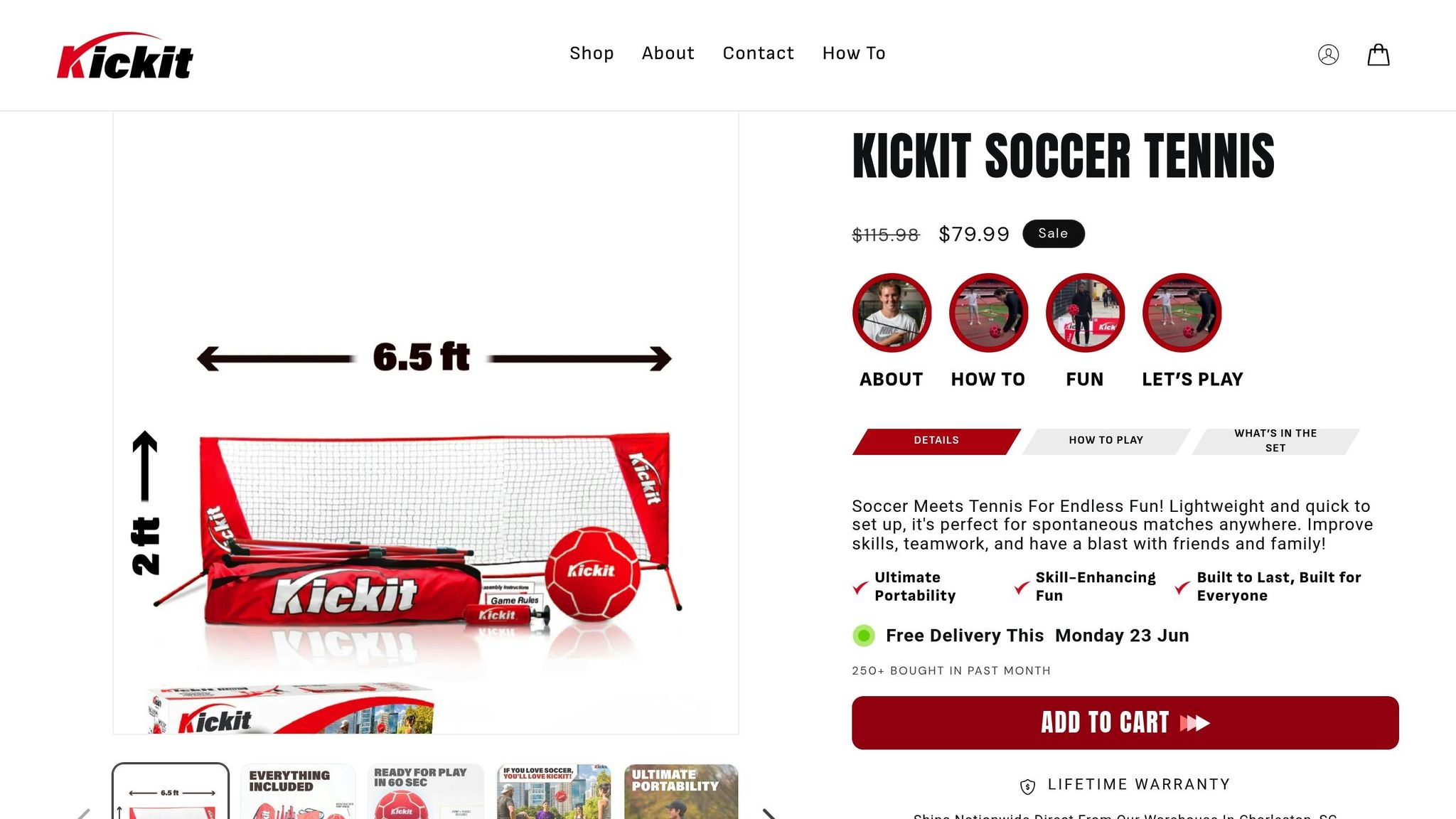
The Kickit Soccer Tennis Set, priced at $79.99, is a must-have for families diving into soccer training. This all-in-one set includes everything you need to transform a flat space into a mini soccer court: a 6.5ft x 2ft net, sturdy steel poles, a lightweight size-5 ball (half the weight of a standard soccer ball), a ball pump, boundary markers, and a convenient carry bag. Best of all, the net sets up in under 60 seconds - no tools required - making it so simple that even kids can help.
The included ball uses air gripping technology, which slows it down during play. This feature makes the game more forgiving and accessible, especially for younger or less experienced players. You can also adjust the ball’s inflation level to modify the difficulty - less air for beginners, more for advanced players. For uneven or sandy surfaces, ensure the poles are securely anchored.
One satisfied Amazon customer, TampaTMM, shared their thoughts in August 2024: “The Kickit Soccer Tennis Set has been an incredible addition to our backyard. It’s a fantastic way for the kids to stay active and have fun. The setup was super easy, and it comes with everything needed to get started right away.”
Kickit Trainers and Accessories
To complement the Soccer Tennis Set, Kickit Trainers are perfect for honing individual skills. The Kickit Pro-Trainers, priced at $39.99, are specifically designed to improve juggling and ball control. These trainers are lighter and offer extra spring, which helps players develop precision and control at a manageable pace. They’re beginner-friendly but still provide enough challenge for more experienced players looking to sharpen their skills.
For families with multiple players, additional Soccer Tennis Balls are available for $24.99 each. These extra balls ensure everyone gets ample practice time without waiting for their turn.
If your family loves doubles play or often hosts larger gatherings, consider the Kickit Soccer Tennis Pro (Doubles) set, priced at $129.99. It’s designed for up to four players, making it ideal for dynamic, team-based games that bring out some friendly competition.
Kickit products are a hit with over 20,000 players, earning an impressive average rating of 4.9 out of 5 stars. Their popularity speaks volumes about their quality and appeal across all ages and skill levels.
For families on a budget, starting with the basic Soccer Tennis Set is a smart move. You can always add trainers and accessories later as your family’s interest grows. This gradual approach allows you to enjoy professional-grade equipment without making a large upfront investment.
With this easy-to-use gear, your family can dive into soccer training right away, building skills and creating memories together.
Safety and Setup Tips
Creating a safe play area ensures your family can focus on having fun and building skills. Here’s how to minimize risks and keep everyone safe.
Setting Up the Play Area
Start by inspecting your play area and removing any obstacles like rocks, sticks, or toys. Pay special attention to areas where kids might sprint or change direction during drills.
Aim for an open space around 30' x 20', though you can adjust this based on the age and skill level of the players. For younger children, clearly marked boundaries can help them stay within the safe area, even if they don’t need as much space.
Check the playing surface thoroughly. Look out for holes, uneven patches, or soft spots that might lead to injuries like twisted ankles. If you’re playing on grass, make sure it’s not too wet or slippery. Indoor sport courts are also a great option since they eliminate risks like uneven surfaces or hidden debris.
Secure all equipment properly to avoid interruptions during play. Afterward, store portable gear in a safe spot to keep it in good condition.
Once your area is set up, it’s time to think about weather and hydration for safe, uninterrupted play.
Weather and Hydration Tips
Once the play area is ready, following weather and hydration guidelines is key to keeping everyone safe, no matter the conditions.
In extreme heat, extra planning is a must. According to U.S. Soccer’s Recognize to Recover program, high temperatures can seriously affect player safety, making hydration a top priority. Schedule games or drills during cooler times of the day, like early morning or evening, and include hydration breaks every 15–20 minutes. Always have water easily accessible and consider shorter or less intense activities when the heat is intense.
For cold weather, dress in adjustable layers. Start with moisture-wicking base layers, add insulating layers, and finish with a wind-resistant outer layer. Make sure there’s a warm spot nearby - like your home or car - where players can take breaks if needed. Be extra cautious when it’s wet or damp, as these conditions can increase injury risks.
Rainy days call for proper footwear with good traction to reduce slipping. Moisture-wicking clothing and waterproof jackets are helpful, and having extra socks, shoes, and towels on hand can make a big difference. While Kickit equipment can handle light moisture, dry it thoroughly after use to avoid damage.
If thunderstorms are in the forecast, prioritize safety. Stop all outdoor activities as soon as a storm approaches, even if you haven’t seen lightning or heard thunder yet. Move everyone indoors to a sturdy building or a hard-topped car, and wait at least 30 minutes after the last thunderclap or lightning flash before heading back outside.
Finally, keep a close eye on younger players or mixed-age groups, particularly in challenging weather or on unfamiliar surfaces. Supervision is crucial for ensuring everyone stays safe and has a great time.
5 Soccer Training Games for Family Fitness
Got your space ready and equipment in hand? These five soccer games are perfect for boosting skills and family fitness while having a blast together. They’re flexible enough to suit all ages and skill levels, so everyone can join in the fun.
1. Soccer Tennis Challenge
Soccer Tennis Challenge is a lively mix of soccer and tennis that’s great for improving ball control, teamwork, and footwork - all while keeping your heart rate up. With a Kickit Soccer Tennis set ($79.99), you can turn your backyard into a mini soccer court.
Set up the net in an area about 20' x 30' (adjust as needed), inflate the ball, and use the included markers to define the boundaries. Split into teams of two. Each side gets up to three touches to return the ball over the net using any body part except hands and arms. Points are scored when the ball lands in the opponent’s court, goes out of bounds, or becomes unreturnable.
Focus on communicating with your teammate and mix up your shots - try lobs or drop shots to keep the other team guessing. The first team to reach a target score, like 21 points, wins.
For younger kids, shrink the court and allow an extra touch. Older players can make it tougher by adding rules like using specific body parts or lowering the net height.
2. Dribble Relay
Dribble Relay is a fast-paced game that sharpens dribbling skills and builds agility. It’s easy to tweak for players of different ages.
Set up cones in a straight line, spacing them about 3 feet apart over a distance of 30 feet (or 20 feet for younger kids). Divide into teams, and give each team a soccer ball. On “Go!”, the first player dribbles around the final cone and back, then passes the ball to the next teammate. The first team to finish wins!
For an extra challenge, older players can practice specific turns like pull-backs or inside/outside foot touches at each cone. You can also try a variation where players dribble down and pass the ball back to the next teammate.
3. Passing Accuracy Contest
Turn passing practice into a fun competition with the Passing Accuracy Contest, a game that hones precision and decision-making.
Set up targets like hula hoops, cones, or small goals at various distances - closer ones (10 feet) for younger kids and farther ones (20–25 feet) for older players. Assign point values based on difficulty. Players take turns aiming for the targets, earning points for each successful pass. Set a time limit, like 60 seconds, to keep the energy high.
For advanced players, create “gates” using two cones about 2 yards apart and practice passing through them with a partner. This variation builds timing and pass control while encouraging teamwork.
Encourage everyone to use both feet to improve versatility and visualize their target before making a pass.
4. Family Scrimmage
A family scrimmage is a fun way to put skills into action while building teamwork. Small-sided games like 2v2 or 3v3 work well, depending on your family size.
Mark out a field using cones or natural boundaries - about 30' x 20' for younger players or 40' x 30' for older ones. Use cones for goals or pick natural markers like trees or fence posts. Keep matches short (5–10 minutes) to keep the energy up and ensure everyone gets plenty of playtime.
Encourage communication and fair play. Younger kids might get extra touches before defenders can challenge, or you can require a set number of passes before scoring to balance the game. Rotate teams often to keep things fresh and give everyone a chance to play with different teammates.
5. Obstacle Course Challenge
Create a soccer-themed obstacle course to test agility, dribbling, and ball control. Using Kickit Trainers ($39.99) and household items, you can design a course that’s fun and challenging for all ages.
Set up cones for weaving, juggling stations with Kickit Trainers, chairs or tables for crawling under while keeping the ball close, and hula hoops for precision dribbling. End with a shooting challenge at a target. Arrange the course in a loop or straight line depending on your space.
Time each family member as they complete the course and track their progress. For younger kids, focus on completing each station, while older players can compete for the fastest time. Add difficulty by increasing the number of juggles, narrowing obstacles, or requiring specific footwork like alternating feet. You can even make it a relay, with each family member tackling a different section.
These games are a great way to stay active, improve soccer skills, and bond as a family - all while having a ton of fun!
sbb-itb-8dc5da3
Modifying Games for All Ages and Abilities
Family soccer games can be easily adjusted to suit players of all ages and skill levels by tweaking rules, field size, and equipment. Once you've got the safety and setup sorted, these changes ensure that everyone - from the youngest to the oldest - can join in and have fun.
For younger children (ages 4–8): Keep it simple and manageable. Shrink the play area - if you usually use a 30' × 20' space, try cutting it down to 15' × 10'. A smaller field helps little ones stay engaged and keeps the game from feeling overwhelming. Swap out the standard soccer ball for a softer, lighter one that’s easier to kick and less intimidating. Sessions should be short - about 5 minutes at a time works well for their attention spans. You can also lower the net height and allow extra touches to make things easier.
For teens (ages 13–17): Add complexity to keep them interested. Use a larger playing area and introduce tactical challenges, like requiring a certain number of passes before scoring or incorporating footwork drills into an obstacle course. Teens can handle regulation-size soccer balls, and encouraging strategic play adds a layer of excitement.
For adults: Stick to standard field sizes and rules for adults, but when mixing skill levels, consider adding handicaps. For instance, experienced players might only use their non-dominant foot or give beginners a head start. These tweaks keep the game fair and enjoyable for everyone.
Blending skill levels can be tricky, but small adjustments make a big difference. Allow less experienced players extra touches or let them start closer to the goal. You might set shooting distances based on age or ability - kids could aim from 10 feet, while adults shoot from 25 feet.
Equipment also plays a role. Using youth-sized goals for younger players or adjusting the height of a Kickit Soccer Tennis net during the game can make things more inclusive. Start with a lower net for kids and raise it when adults take their turn.
For a fun twist, try themed games like "Pirate Soccer" or "Superhero Training." These creative spins are great for mixed-age groups, giving younger players an exciting context while still challenging older participants.
Let everyone contribute their own ideas for modifications. Kids are especially good at coming up with imaginative twists, like adding a "freeze dance" challenge to dribbling drills or inventing a point system that rewards different abilities.
The goal is to create a game where everyone feels challenged but not overwhelmed. Don’t hesitate to tweak the rules on the fly as the game unfolds. The best family soccer games are those that naturally evolve to keep everyone engaged.
Next, we’ll explore how to track your family’s progress and celebrate those soccer milestones together.
Tracking Progress and Celebrating Success
Keep tabs on your family's soccer journey with straightforward tools. Regular tracking not only helps build skills but also strengthens family bonds during practice sessions.
Recording Improvements
Measure progress using simple metrics like success rates and completion times. Here are a few ways to track performance:
- Passing accuracy: Count how many passes out of 10 are successful.
- Speed drills: Use a stopwatch to time obstacle courses or dribbling drills.
- Technical skills: Record the number of ball touches in 30 seconds or consecutive successful headers.
- Physical progress: Track sprint times in the yard or the distance covered during passing drills.
Log these numbers in a notebook or a notes app on your phone. For example, Dad might go from completing 6 out of 10 passes in the first week to 8 out of 10 by week three. Meanwhile, a 12-year-old could shave their dribbling time from 45.3 seconds to 38.7 seconds after a month of practice.
"The ability to execute skilled movement patterns efficiently and effectively is the most important aspect of soccer performance and players must apply cognitive, perceptual and motor skills to rapidly changing situations."
Focus on individual progress rather than comparisons. If 8-year-old Sarah improves her dribbling time by 2.1 seconds, it's just as meaningful as teenage Mike nailing 15 consecutive ball touches.
Consider creating personal progress charts for each family member. A simple sheet of paper taped to the fridge works great. Adjust metrics to suit different ages and skill levels, and once you see progress, make it a point to celebrate together.
Celebrating Achievements
Celebrate milestones with enthusiasm - cheers, high-fives, or even a quick pause to acknowledge the accomplishment. Whether it's completing 20 passes in a row or finishing an obstacle course in under 40 seconds, take a moment to gather and celebrate.
Set up a "Wall of Accomplishments" with photos from your soccer sessions and notes on key improvements. This visual display can highlight everything from Mom's first successful bicycle kick to Tommy's passing accuracy jumping from 40% to 70%.
Mark big milestones with small, meaningful rewards. A handwritten certificate like "Most Improved Dribbler" or "Passing Accuracy Champion" can become a cherished keepsake. If everyone hits their personal bests by a set percentage, celebrate with a special family dinner or a fun outing to watch a local soccer game.
Most importantly, celebrate effort and persistence, not just results. Recognize the family member who practiced regularly despite slow progress, or the one who cheered everyone on with great sportsmanship. By tracking progress and celebrating achievements, you’ll keep the energy high and the whole family motivated.
Conclusion
Soccer training games turn family fitness into an exciting adventure that everyone can look forward to. They bring together physical activity, skill-building, and meaningful family time, creating benefits that stretch well beyond the backyard.
The physical perks alone make these games worth it. Soccer training is a full-body workout - it strengthens your heart, tones muscles, boosts flexibility, and builds endurance. Plus, it’s a fantastic way to get everyone moving, cutting down on screen time while relieving stress and improving mental health.
But it’s not just about fitness. These games have a way of bringing families closer. Working as a team, practicing patience, and celebrating small victories together can strengthen relationships and improve communication.
Kickit products make it even easier to dive into these activities. Their gear is simple to use, portable, and designed for all ages, so you can bring the fun anywhere - whether it’s the park, the beach, or even a camping trip.
What’s great about these games is their flexibility. They’re easy to fit into your schedule, require minimal equipment, and can be adjusted as skills develop. Whether your family is just starting out or looking to level up, these activities grow with you.
The best part? These games emphasize effort and teamwork over winning. Every family member gets a chance to shine, build confidence, and contribute to a positive group dynamic. It’s about more than just playing a game - it’s about making memories that stick.
Grab a ball, gather your family, and make these games a regular part of your routine. You’ll boost skills, stay active, and create moments you’ll all cherish for years to come.
FAQs
How can we make these soccer training games fun and suitable for families with kids and adults of different skill levels?
To make soccer training games enjoyable for families with kids and adults of different skill levels, it’s important to focus on activities that encourage teamwork and are easy to adjust. Try using smaller goals, softer balls, or tweaking the rules to suit younger or less experienced players. For instance, you can slow down the pace of play or simplify skills like dribbling and passing to make it easier for everyone to join in.
You can also include activities that bring people together, such as relay races, obstacle courses, or group challenges. These types of games let everyone participate at their own comfort level while keeping the energy upbeat and fun. The goal is to create a relaxed and welcoming atmosphere where every family member feels like they’re part of the action.
How can we ensure everyone stays safe during family soccer games, especially in different types of weather?
To ensure everyone stays safe while playing, it’s important to dress appropriately and wear the right footwear. Start with a proper warm-up and keep yourself hydrated throughout.
When the weather is hot, avoid playing if the temperature hits 95°F or higher, and make sure to take frequent breaks in the shade. In colder conditions, layer your clothing to stay warm and avoid playing if the wind chill dips below 0°F. On rainy or wet days, wear bright colors to stay visible and be extra cautious on slippery surfaces.
Adapt the game’s length and equipment to match the weather conditions, so everyone can enjoy a safe and enjoyable experience.
What are some ways to track progress and celebrate achievements during family soccer training games?
Tracking progress as a family can turn soccer training into an even more enjoyable and meaningful experience. One simple way to do this is by keeping a log of milestones - whether it’s nailing a tricky skill or completing a fitness challenge. Celebrate these achievements with small rewards or fun family activities, like a movie night or a favorite meal.
If you’re looking for a more organized way to track progress, there are apps and tools available that can help monitor skill development and performance. Setting clear, short-term goals for each family member and recognizing their efforts - through words of encouragement, certificates, or even a fun outing - can go a long way in keeping everyone motivated. The focus should always be on growth and teamwork, making the journey as enjoyable as the destination.

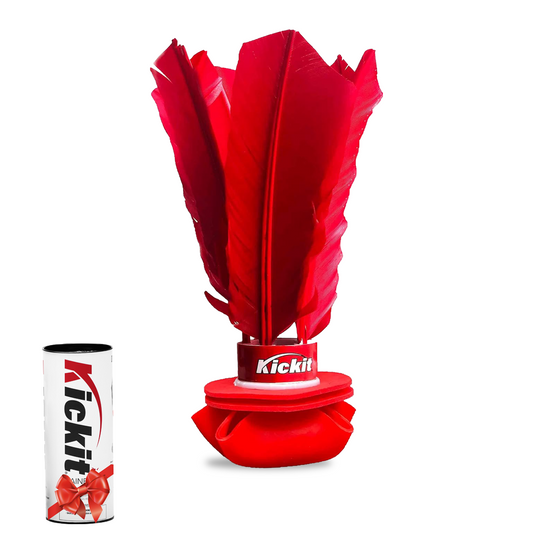
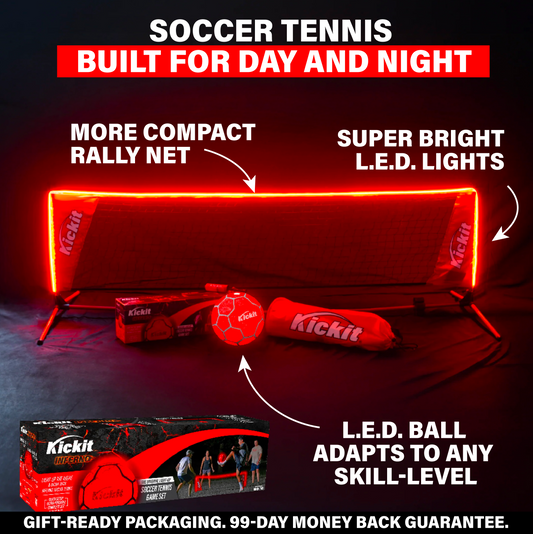
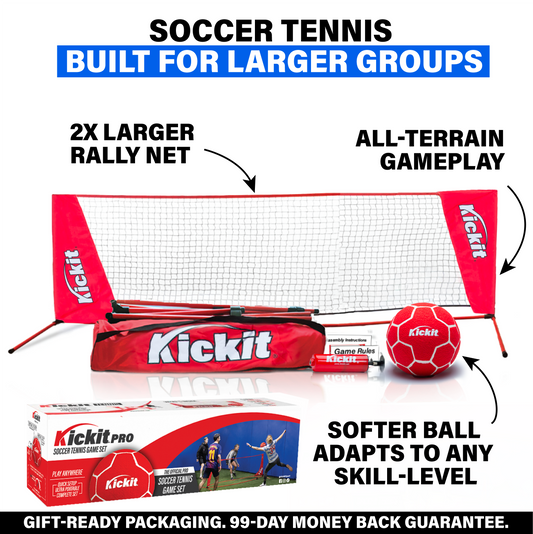
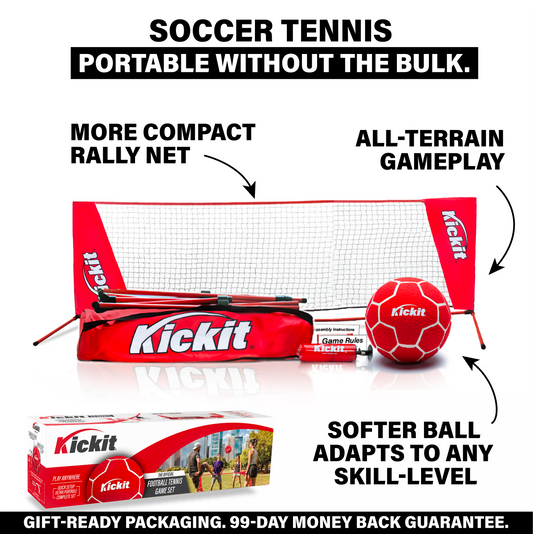
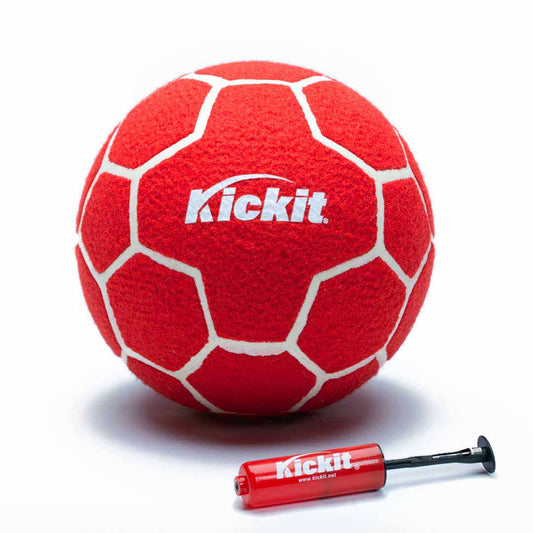
![[NEW] Inferno Kickit](http://kickit.net/cdn/shop/files/LED-Trainer_callouts.png?v=1761855747&width=533)

